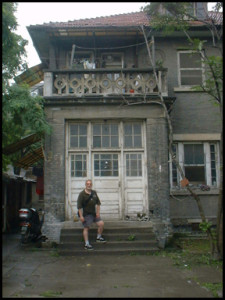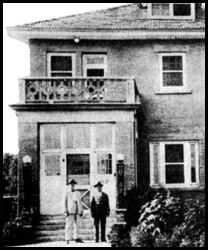

Left: Author at Rabe House, 2001,
Photo: N. Lai Rabe (L) at his home, 1937
The map that that showed the location of his house was one I had copied from a book was little more than a sketch itself; the map I bought in Nanjing was in Chinese except for a few streets and sights in English. I had to hope that the streets hadn’t been re-routed since 1937 as I tried to match them up. The area was looking for, what was an International Safety Zone in 1937, now abutted the sprawling campus of Nanjing University. When I got there, a few blocks from my hotel, the area was a bustling old district that probably won’t survive a few more years of Chinese economic expansion. Already there were hutongs —the old dense and squalid neighborhoods surrounded by walls—nearby that were falling to the wrecker’s ball to make way for the almost pre-obsolesced international style crud that is going up everywhere.
I wandered around the narrow streets looking for somebody old, quite old, until I saw a tall, white-haired man ambling along on legs that looked like parentheses. I had only a few words of Mandarin, but hoped that one word would be enough. I put myself in front of him. “Dui bu qi, zai nar Rabe.” I couldn’t think of the word for “house,” so it sounded like I was looking for Rabe himself, who has been dead since 1949. “RAH-behr, RAH-behr,” I intoned, hoping I wouldn’t get a “Wo bu dong” reply.
“Ahhh, Rah-behr, RAH-behr,” he said through a zillion-cigarette voice, breaking into a slight smile, and shuffling off with a little “follow me” wave. He looked back over his shoulder once: “RAH-behr?” he said, checking to see if he had understood me correctly. The streets were full of people hauling plastic bags on their morning food shopping rounds. Stalls and carts offered all sorts of vegetables, beverages, and Chinese “fast food” like crepes and those bagel-sized buns that are cooked on the inside of brick-lined metal drums. I don’t think the scene was this colloquial in 1937 when this area was the site of embassies and consulates.
At the end of the block we came to a wall with a gate and walked through. The courtyard contained some people, cooking on braziers. But there stood the house. I recognized it instantly as Rabe’s house, the house that in 1937 was the home of a German businessman for the German industrial company, Seimans. Were it not for the oriental railing above the porch lintel, it looked like a dwelling one might find in the Ulandstrasse in Munich. After reading his diaries and other accounts of his years in Nanking, I almost felt I was home. There was that dingy gray-brown brick, the unusual window mullions. But it seemed smaller, and more enclosed by the trees and the compound wall. There were no historical markers, and it seemed to be occupied. It had not been turned into a shrine for the man who has been called the “Schindler of China.” I wondered if it would survive the onslaught of redevelopment that was taking place in Nanking, whether the University might be able to incorporate it into its sycamore-shaded campus. [1]
I imagined the courtyard filled with terrified Chinese seeking some sort of asylum over sixty years before. Outside Japanese troops were slaughtering Chinese by the tens of thousands, drunk with their conquest of the erstwhile capitol of the Kuomintang that had abandoned it. Screams and gunfire could be heard, the air was thick with the smoke from burning buildings and bodies. The most horrible atrocities went on for weeks during the end of 1937 and beginning of 1938 in what came to be called the “Rape of Nanking.”
It was the home of a member of a representative of the country that was an ally of Japan, Nazi Germany, although Rabe had lived in China for some thirty years. Outraged at the atrocities Rabe was not only a leader in negotiating with the Japanese to set up an International Safety Zone for the various foreign delegations, but in directly interfering in their murderous activities by Chinese civilians and left-behind military. In one account, given by Iris Chang, Rabe, incensed by the rapes, which often ended in the murder of the woman, strapped on swastika armband and charged into a group of drunken Japanese soldiers to upbraid them and force them to surrender the woman to him. He had no more that the axis between the Nazis and the Japanese against the chance that his body might end up with the thousands of others. [2]
The irony of a Nazi who admired Hitler engaging in such selfless risk would seem to be the sort of historical stuff that merits more attention that it has received. There were many other westerners among the foreign lo wai who occupied the concession areas and eventually the Safety Zone that Rabe was instrumental in securing from the Japanese military. Many were journalists, but little as emerged from their pens. Yet Rabe is responsible for saving more than 200,000 Nankingese, and gave as many as 600 shelter in his own home and yard. There were other westerners who were responsible for saving Chinese lives. One of them, Minnie Vautrin, was an American Midwesterner who was headmistress of a women’s college in Nanking and herself faced down rampaging Japanese troops, saving as many as ten-thousand Chinese. [3]
The second irony is when Rabe returned to Germany during the war. He wrote to Hitler about the atrocities, but of course, Hitler was going the Japanese more than one better with his own campaign of extermination. Rabe, a hero in China, was arrested by the Gestapo. He was a “nobody” in his own country, and died almost shilllingless of a stroke His diaries, ultimately made available by his sister, were not published until 1997. [4] To read them is to be transported back seventy years to one of the most horrific instances of man’s inhumanity to man, and an act of compassion that keeps the candle of hope from guttering to its last flicker. If only the walls of Rabe House could talk; they might whisper “ xie-xie ,” . . . and Germans who have little to be proud of from the dark years of WWII my respond with a well-deserved “ Danke .”[5]
___________________________________
©2006, James A. Clapp (UrbisMedia Ltd. Pub. 6.17.2006)
[1] Beside the Rape of Nanking Memorial Museum there is a small building devoted to Rabe containing a sculpture of him and documents and photos. It was recently reported in the South China Morning Post that Rabe’s house is being restored by the Nanjing University and will be opened to the public as a museum..
[2] Despite his 30 years residency in China Rabe did not speak the language, relying on some pidgen and his fluency in English.
[3] Hual-Ling Hu, American Goddess at the Rape of Nanking: The Courage of Minnie Vautrin (2000). Vautrin is also still revered by Nanjingese who remember her service.
[4] The Good Man of Nanking , Translated by John E. Woods (Vintage)
[5] Rabe may finally be getting some recognition. Reportedly there are as man as three film projects in development, one by the writer who was responsible for the HBO series, Rome.
